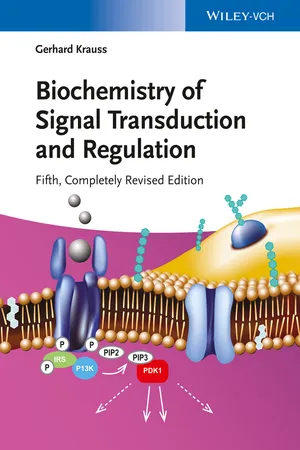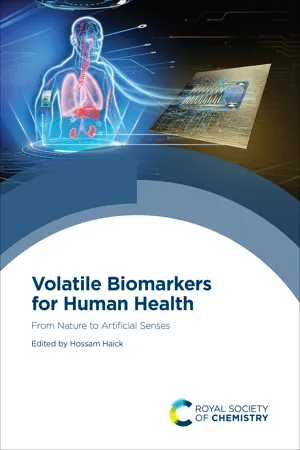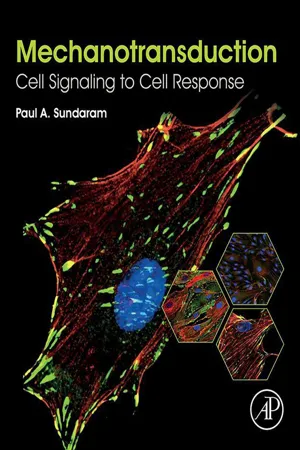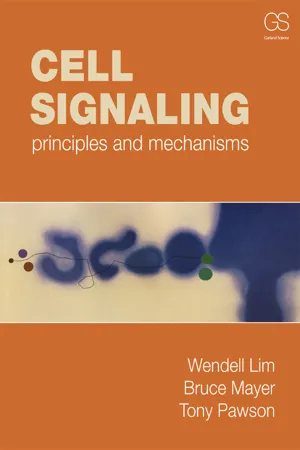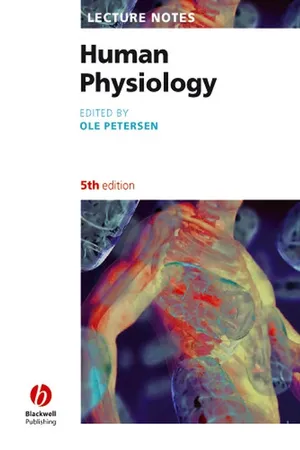Biological Sciences
Paracrine Signaling
Paracrine signaling is a form of cell communication in which a cell releases signaling molecules into the extracellular fluid to affect nearby target cells. These signaling molecules, such as growth factors or cytokines, bind to receptors on neighboring cells, triggering a response. This type of signaling allows for local coordination of cellular activities within a tissue or organ.
Written by Perlego with AI-assistance
Related key terms
Related key terms
1 of 4
Related key terms
1 of 3
9 Key excerpts on "Paracrine Signaling"
- eBook - ePub
- Marc J. Klowden(Author)
- 2013(Publication Date)
- Academic Press(Publisher)
juxtacrine signaling , this is the fastest mode of communication and can be found in cardiac muscle cells whose contractions are coordinated, allowing these to occur simultaneously. Contact-dependent signaling also occurs during early development, giving adjacent cells information about their location relative to other cells, and can specify their developmental fate.Neuronal signaling delivers messages across long distances within the organism to specific cells. As described in Chapter 11 , a signaling neuron sends an electrical signal along its axon that triggers the release of a neurotransmitter at its synapse with a target cell (Figure 1.3C ). The neurotransmitter binds to postsynaptic receptors in target cells, causing a physiological response in those cells. The speed of transmission is rapid, but depends on the physical distance over which the signal must travel.Paracrine and endocrine signaling both involve the diffusion of signal molecules through an extracellular medium. Endocrine signaling is the most public, releasing hormones into the blood that are distributed to all cells of the body (Figure 1.3D ). Only those cells with receptors that recognize the hormone are capable of responding. The signaling cells may consist of endocrine cells or more specialized neurosecretory cells. Some endocrine signaling molecules are hydrophobic and are able to cross the cell membrane and bind to internal receptor proteins, but most others are peptides that must remain outside and bind to external receptors.Paracrine Signaling is more intimate, with the signal molecules diffusing not through the blood but through the extracellular matrix instead (Figure 1.3E ). The proteins secreted by the target cells are effective over only a short distance and induce changes only in neighboring cells that bear specific receptors localized in regions of cytoplasmic extensions called cytonemes - Gerhard Krauss(Author)
- 2014(Publication Date)
- Wiley-VCH(Publisher)
The hormone reaches the target cells from the hormone-producing cell by passive diffusion. The producing cell must be found in the vicinity of the receiving cells for this type of communication. The signaling is rather local, and the participating signaling molecules are sometimes termed tissue hormones or local mediators. One special case of paracrine signal transduction is that of synaptic neurotransmission, in which a nerve cell communicates with either another nerve cell or with a muscle cell. 1.3.3.3 Autocrine Signaling In autocrine signaling, cells of the same type communicate with one another. The hormone produced by the signaling cell affects a cell of the same type by binding to receptors on these cells, initiating an intracellular signal cascade. If an autocrine hormone is secreted simultaneously by many cells, then a strong response is triggered. Autocrine mechanisms are of particular importance in the immune response. 1.3.4 Direct Protein Modification by Signaling Molecules A special case of intercellular signaling is represented by a class of small, reactive signaling molecules, such as nitric oxide (NO; see Section 8.10). NO is synthesized in a cell in response to an external signal and is delivered to the extracellular fluid. NO reaches neighboring cells either by diffusion or in a protein-bound form, and a modification of the target enzymes ensues which results in a change in the activity of these enzymes. NO is characterized as a mediator that lacks a receptor in the classical sense. 1.4 Intracellular Signaling: Basics External signals such as hormones, sensory signals or electrical signals are specifically recognized by receptors that transduce the external signal into an intracellular signaling chain- eBook - ePub
Volatile Biomarkers for Human Health
From Nature to Artificial Senses
- Hossam Haick, Hossam Haick(Authors)
- 2022(Publication Date)
- Royal Society of Chemistry(Publisher)
Part 2: Communication: Volatile Biomarkers as a Signaling AgentsPassage contains an image Chapter 9 Signal Transfer and Transduction between Cells
Mamatha Serasanambatia , Dina Hashoul,b and Hossam Haick,ba a Department of Medicine, Washington University in St. Louis, St. Louis, MO 63110, USA;b Department of Chemical Engineering and Russell Berrie Nanotechnology Institute, Technion – Israel Institute of Technology, Haifa 3200003, IsraelEmail: [email protected]9.1 Introduction
Cell-to-cell communication has a critical role during tumor development and progression, allowing cancer cells to reprogram the surrounding tumor microenvironment and cells located at distant sites.1 ,2Cells communicate by several means, nonetheless, with broadly three types of cell communication: autocrine, paracrine and juxtacrine signaling.3 In autocrine signaling, a cell secretes a chemical messenger and has the cognate receptor, thereby allowing it to communicate with itself and other cells of the same type. Paracrine Signaling involves at least two types of cells: one cell type without the cognate receptor secretes a chemical message, whereas another cell type has the cognate receptor but does not secrete the biomolecule. Lastly, juxtacrine signaling involves two cells in which one cell has a membrane-bound ligand that binds to its cognate receptor on another cell.2 –5Proteomic and genomic approaches have been the main approaches to study signaling communication in cell proliferation, migration, cell recognition and differentiation.6 Though tremendous advances have been achieved, several limitations restrict the fulfilment of approaches to diagnosis and therapeutic applications. These limitations include but are not confined to:5 –9(1) proteomics and genomics requiring prior and accurate knowledge of specific genes or proteins, exclusive to in vitro and in vivo trials – something that does not necessarily reflect real-life situations; and (2) genomics and proteomics, which continue to be expensive and of low specificity and which require complex analytical algorithms that are prolonged and cumbersome. Since cancer is a systematic disease (polygenetic) that involves several mutations at different sites8 (genetic, epigenetic, local to or at a distance from the primary tumor, etc. - Timir Tripathi, Vikash Kumar Dubey, Timir Tripathi, Vikash Kumar Dubey(Authors)
- 2022(Publication Date)
- Academic Press(Publisher)
Cells can also send messages to the nearby cell via direct cell-to-cell contact, where the signaling factor or ligand is a membrane-bound protein. Signals or ligands can cause signaling events in local areas surrounding the inducer/secreting cell and are called paracrine factors. It is a form of short-range signaling. Examples of paracrine factors are different growth factors, neurotransmitters, morphogens, etc. Some signaling molecules can travel long distances to other organs or tissues where the target cells reside. These chemical messengers are endocrine factors or hormones. Hormones like estrogen and testosterone are derived from cholesterol and hence can pass through the cell membrane directly and bind to its receptors located in the cytoplasm. 3 Insulin, follicular stimulating hormone (FSH), etc., are peptide derived and thus cannot cross the plasma membrane of the cells and require binding to cell surface receptors for signal transduction. 4 Cells also secrete chemical factors that act on the same cell. These are called autocrine factors and include molecules like interleukin-2 (IL-2) which is involved in the clonal proliferation of activated T-cells. 5 Environmental cues are not always chemical signals but also include physical factors such as mechanical pressure, light and sound. Cells respond to these signals with appropriate signal transduction events, but they rarely fall under cell-to-cell communication due to the absence of an inducer cell. 2.2: Receptors Specific ligands carry specific messages. Responder cells receive these messages with the help of specific receptors, which provide specific sites for docking of the ligand. Ligand binding is followed by a downstream signaling cascade, where a series of intracellular components, often proteins, are activated. Based on the location of receptors on the cell, they can be grouped into two major classes: Cell surface receptors and Cytoplasmic/Nuclear receptors- eBook - ePub
Essential Physiological Biochemistry
An Organ-Based Approach
- Stephen Reed(Author)
- 2013(Publication Date)
- Wiley(Publisher)
It would not be conducive to learning if a biochemistry lecture were to be held in the same lecture theatre at the same time as a presentation on, say, French literature of the seventeenth century. Multicellularity allows efficiency through metabolic and physiological specialization, but the disadvantage is ensuring coordinated activity; team work is vital for physiological success. Coordination of metabolic activity is achieved by an intricate system of communication where signalling molecules such as hormones (derived from the Greek for ‘ arouse to activity ’ and sometimes called the ‘first messengers’), growth factors, cytokines, and neurotransmitters are released by one cell and target (i) a distant cell (classic hormones), (ii) a neighbouring cell (local hormones and neurotransmitters) or (iii) the same cell (autocrine hormones), and initiate an appropriate metabolic and physiological response in that target. The word ligand describes a small molecule which binds to a larger molecule and in the context of cellular communication means the primary signal (hormone, neurotransmitter, growth factor, etc.). Cell signalling and signal transduction are topics of great research interest, partly because defects of these processes are associated with diseases such as type 2 diabetes, cancer and obesity. In recognition of this is the fact that a number of Nobel Prizes for Medicine or Chemistry have been awarded to researchers of cell communication. This chapter describes the nature of the disparate signalling molecules and how they regulate the activity of their targets. 4.2 Physiological aspects 4.2.1 The classical endocrine system The classical endocrine system is composed of a series of glands that secrete hormones directly into the blood where they are carried to act on cells in the body often quite distant from the place of secretion. Insulin, for example, secreted from β pancreatic islet cells has actions on fuel metabolism in most tissues of the body - eBook - ePub
Mechanotransduction
Cell Signaling to Cell Response
- Paul A. Sundaram(Author)
- 2020(Publication Date)
- Academic Press(Publisher)
The distance effect on cell signaling is summarized in Fig. 2.2. Figure 2.2 Cell communication methods. (A) Autocrine signaling illustrating the release of ligands by a cell to be received by its own receptor and accomplish the physiological function of the cell. (B) During direct contact signaling, the cells are in contact with each other where the effector cell secretes the required chemical signal into the target cell. (C) Paracrine Signaling, indicating close proximity of effector and target cells where ligands from the effector cells are released for binding with receptors in the target cells. (D) Endocrine signaling, where the effector and target cells are at a considerable distance from each other, and the ligand is transported long distances to elicit a response from the target cell. 2.3 Phases in cell signaling The cell signaling process can be divided into three distinct phases, which occur in the following order, reception, transduction, and response. This means that transduction cannot take place before reception and neither can response occur before signal reception and transduction. 2.3.1 Reception Cell signaling is normally initiated when a small molecule or even a larger protein is released by one set of cells to trigger a response. This initiator signal, commonly called a ligand, attaches to a cell receptor, as seen in Fig. 2.3. This signaling molecule is sometimes called a first messenger. The receptor is responsible for receiving the signal and is normally a transmembranal protein. This phase of cell communication is called reception. Fig. 2.3 further illustrates that only a specific ligand can attach to a specific receptor to activate it. The analogy is similar to a lock and key. Only a specific key (ligand) can open a particular lock (receptor) under normal operating conditions and the ligand attaches to a specific binding site on the receptor to activate it - eBook - ePub
- Wendell Lim, Bruce Mayer, Tony Pawson(Authors)
- 2014(Publication Date)
- Garland Science(Publisher)
1 Introduction to Cell SignalingAll living cells perceive signals from the outside environment and adjust their behavior accordingly. If you think back to the earliest living cells, it is easy to imagine the incredible pressure they were under to evolve the ability to sense features of the environment and to change in response to these signals. The ability to sense and move toward nutrients, or to sense and avoid stresses and toxins, would give a unicellular organism a huge competitive advantage. This ability to respond to environmental cues is important for single cells, but it is also absolutely essential for the normal development and functioning of multicellular organisms, which depend on a continuous and extensive exchange of information to coordinate the activities of many individual cells. Furthermore, when this cellular communication goes awry, it can result in diseases such as cancer. In this chapter, we will introduce the basic principles of cell signaling and the molecular mechanisms that underlie it.What Is Cell Signaling?
Cells are the smallest fundamental units of life. Part of what makes them so distinctly “living” is their remarkable ability to sense stimuli and to respond to them in a dynamic manner. This ability of cells to detect or receive information and process it to make decisions can also be considered from the broader perspective of information processing. Here we can draw analogies to the engineering and design principles of other, more familiar information-processing systems, such as human- made electronic devices. It is this interface between the unique properties of living systems and the more universal properties of any system that processes information that makes the study of cellular signaling mechanisms so compelling. - No longer available |Learn more
- Mary Wuerth(Author)
- 2023(Publication Date)
- Barrons Educational Services(Publisher)
UNIT 4Cell Communication and Cell CyclePassage contains an image
10
Cell Communication and Signaling
Learning ObjectivesIn this chapter, you will learn:➜Types of Cell Signaling➜Signal Transduction➜Disruptions in Signal Transduction Pathways➜Feedback MechanismsOverview
Biological systems interact, exchange information about their environments, and respond to this information. Life often depends on responding quickly to changing environmental conditions. This chapter reviews the basics of cell communication and the process of signal transduction.Types of Cell Signaling
The survival of a living organism depends on the ability of its cell, or cells, to communicate by sending, receiving, and responding to chemical signals. These chemical signals are called ligands. Figures 10.1–10.4 show four general types of cell signaling:1.Autocrine signaling—In autocrine signaling, the cell secretes a ligand. This ligand then binds to a receptor on the cell that secreted the ligand, triggering a response within that same cell. The root word auto means “self,” so this process can be thought of as a cell signaling itself to generate a response. An example of this is a cancer cell, which releases its own growth hormones (the ligands) that stimulate the cancer cell to grow and divide.Figure 10.1 Autocrine Signaling2.Juxtacrine signaling—This is signaling that depends on direct contact between the cell that is sending the ligand and the cell that is receiving and responding to it via a surface receptor. Examples of juxtacrine signaling include plasmodesmata in plants (which involve the ligand traveling between channels that connect adjacent cells) and antigen-presenting cells in the human immune system (which signal helper T cells through direct cell-to-cell contact).Figure 10.2 Juxtacrine Signaling3.Paracrine Signaling - eBook - ePub
Lecture Notes
Human Physiology
- Ole H. Petersen, Ole H. Petersen(Authors)
- 2019(Publication Date)
- Wiley-Blackwell(Publisher)
Cells communicate with one another by chemical signals that either diffuse between cells (neurotransmitters, and paracrine and autocrine agents), or are disseminated in the blood (hormones). These signals include small organic molecules (e.g. acetylcholine and adrenaline), and larger molecules such as proteins and steroids. Cells may also communicate with their immediate neighbours through gap junctions, which transmit both electrical and chemical signals.Chemical signalling
The nervous and endocrine systems use chemical signals, neurotransmitters and hormones, respectively, for communication. Neurotransmitters are released from neurones, diffuse across a narrow synaptic space or cleft (<100 nm) and act on adjacent neurones, muscle cells or secretory cells in glands; hormones are transmitted in the circulation and act on cells of distant target organs. Hormones act at very low concentrations, typically 10−6 to 10−9 mol L−1 (but in some cases as low as 10−12 mol L−1 ), while the concentrations of neurotransmitters in synaptic clefts may reach 5 × 10−4 mol L−1 (e.g. acetylcholine at the neuromuscular junction). In addition there are paracrine agents released locally by cells that act on neighbouring cells and autocrine agents that act on the cells that produced them. Therefore neurotransmitters, by definition, are paracrine agents, although they are not usually classified as such, and some hormones, e.g. gastrointestinal hormones, may also be classified as paracrine agents, because they may act locally as well as travelling in the blood stream to distant target organs. Secretions of neurones that are transported to distant target organs in the blood stream are referred to as neurohormones. Finally, certain cells secrete growth factors that are essential at critical stages in the development of their target cells.Chemical signals may be ions or metabolites (e.g. Ca2+ , glucose or amino acids) which stimulate certain endocrine cells; they may be simple organic molecules (e.g. the neurotransmitters acetylcholine, noradrenaline and glutamate), or they may be more complex molecules (e.g. protein and steroid hormones). Even dissolved gases such as nitric oxide and carbon monoxide may act as chemical signals between cells. Many substances that were first identified as hormones produced in endocrine glands are also synthesized in the nervous system where they act as neurotransmitters or neuromodulators (see Chapter 3
Index pages curate the most relevant extracts from our library of academic textbooks. They’ve been created using an in-house natural language model (NLM), each adding context and meaning to key research topics.
Explore more topic indexes
Explore more topic indexes
1 of 6
Explore more topic indexes
1 of 4

